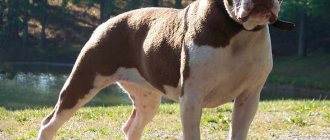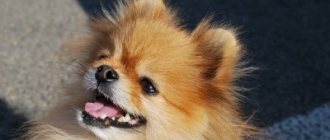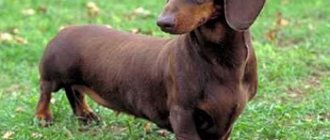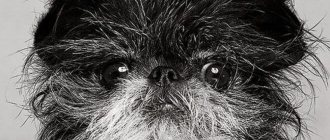Video
* We invite you to watch a video about the Poodle . In fact, in front of you is a playlist in which you can select and watch any of 20 videos about a given dog breed by simply clicking on the button in the upper right corner of the window. In addition, the material contains quite a lot of photos. By looking at them you can find out what a Poodle looks like.
In this article:
|
Rate the material!
[Total votes: 3 Average: 3.7]
The poodle is a graceful dog that people remember thanks to its unusual haircuts and natural grace. Few people know that the poodle is one of the smartest dog breeds in the world. These cute pets have intelligence that they inherited from their ancestors, hunting dogs.
History of the origin of poodles
The Poodle is a very old breed of dog that was originally bred as a toy dog. The ancestors of poodles date back to the 12th century - they were depicted on Greek and Roman coins and in the Monastery of Mont Real in Sicily.
Poodles gained fame in the Middle Ages. Poodles have been repeatedly depicted in paintings and sculptures - especially in the Baroque and Rococo eras. Europe was obsessed with this breed, so almost all noble people had poodles. In 1555, the first description of the breed appeared, and already in 1563 the poodle was divided into varieties: large, dwarf and multi-colored.
How exactly the poodle appeared is unknown. It is generally accepted that it arose due to the crossing of two breeds of dogs. The first was a German Cattle Dog with a distinctive curly coat. This dog was a good duck hunter, she brought the shot game from the water.
The second relative of the poodle is the so-called “water dog,” which was popular in Spain. Its wool was in the form of long strands and was also used for hunting waterfowl. Both poodle ancestors had excellent hunting qualities and intelligence, which was passed on to the poodle.
At first, poodles as a breed were formed in France, from where they spread throughout all countries. At first they were used as guard and hunting dogs, only then their thick hair and elegant constitution attracted the attention of the nobility.
Fun fact: Poodles were a success in medieval France. The poodle was a favorite of the palace nobility and an adornment for wealthy women. Later, thanks to their intelligence, poodles took their place in circus performances and began to accompany traveling performers. Around that time, poodles began to get original haircuts that the audience liked.
In Russia, the poodle became popular in the mid-18th century among the Russian nobility. Ekaterina was the first to receive a poodle - he was brought to her from France. Later, poodles became widespread among ordinary people. For example, during the Great Patriotic War, poodles searched for mines and were used as messenger dogs.
History of the breed
It’s paradoxical, but one of the oldest dogs, the poodle, had no homeland a hundred years ago. The primacy of the “birth” of the breed was disputed by the French, Germans and Italians. Selincourt in the 17th century was sure that the poodle originated from Piedmont. And the authoritative German naturalist Bram in his famous “History of Animals” defends its German roots.
A well-known Swiss specialist who studies the history of the poodle, Rosa Engler, claims that Central Asia (Tibet, Mongolia) can be considered the ancient homeland of dogs with shaggy hair. Their spread was facilitated by ancient sailors - the Phoenicians, who brought these dogs to the port cities of the Mediterranean.
According to this version, herding dogs first came to North Africa and only then to Europe. Later, under the name “barbet”, these dogs settled in Europe as shepherds of sheep flocks through France. The piquancy of the situation lies in the fact that the probable homeland of the poodle can be considered any place where shaggy shepherd dogs appeared. This explains the difficulty of establishing the country of origin of this breed. Today's poodle has, to a greater or lesser extent, the blood of Russian, Hungarian, Spanish, German or French dogs.
The ancestors of the poodle began to arrive in southern Europe at the beginning of the second millennium with the Moors, then with Mediterranean pirates and subsequently with merchant ships. They came from North Africa, where they helped the Berber tribes graze their herds and flocks, and having turned into sailors, they worked together with the crews: they pulled “ends” out of the water, were the first to jump ashore to moor the boat, and pulled nets on board.
Having moved to Europe, the ancestors of the poodle gave rise to many breeds, such as the Portuguese and Spanish “water dogs”. In France, you can trace its immediate ancestors, about which (water dogs covered with thick curly hair) there is a lot of documentary evidence. They are depicted in the Amiens Cathedral together with the holy martyr Firmin. Their hunting qualities were highly valued by Henry IV (1589–1610). The scientist Leclerc Comte de Buffon in his Natural History (1749–1788) divides the breed into two varieties according to size, both cut “like a lion.” From noble kennels, where they were kept for hunting game birds, they gradually moved to aristocratic salons.
The poodle is a very ancient breed of dog. In the drawings of ancient Greece you can see small dogs with a lion-like appearance. In the 12th-13th centuries, artists from Sicily and France depicted them on their canvases, then from Central and Western Europe, and in the 14th century from England. The works of classics of world art indicate the spread of the breed in the Netherlands and Germany, where the poodle was a companion at court and in aristocratic circles. The poodle not only entertained high society, but also participated in wars, finding the wounded and delivering messages, and also helped veterans earn a living by demonstrating their abilities at fairs and receiving rewards for this.
Poodle - description of the breed
Depending on the type of poodle, the following breed varieties are distinguished:
- Royal are large dogs weighing up to 23 kg, and height from 48 to 58 cm, at the withers. They have an elegant appearance and long legs;
- Average – 35-44 cm, height, weight from 9 to 12 kg;
- A small poodle is a dog with a height of 28 to 34 cm, weighing from 6 to 8 kg;
- Dwarf - the smallest representatives, up to 25 cm tall, weighing up to 5.5 kg.
The head of poodles is elongated, with clearly defined lines, pointed at the end. The lips fit tightly to the teeth, the teeth close together. Scissor bite. The eyes are large, round in shape and wide set. As a rule, black and brown colors - light-eyed individuals are rejected. If the poodle has a dark chocolate color, then amber pupils are allowed.
Poodles have long, drooping ears, completely covered with soft, wavy hair. The bases of the ears are located at eye level. The ears are quite long: if you stretch them out, they can reach the end of the muzzle.
The poodle's torso is elongated, graceful, but strong. Wide, flat back without sagging. Long legs, springy step. The paws are slightly rounded, elongated, the toes fit tightly to each other. Tightly tucked narrow belly, wide rib cage. When running, the step becomes sweeping, the poodle spreads its legs wide.
The tail is set high, looking upward, very thin, tapering towards the end, but on a strong base. The pelvis is narrow, but proportional. The croup is slightly sloping down.
Popular Poodle Colors
Poodles come in a wide variety of colors, but in general they are all classic hunting dog colors. For example, black color is one of the most common. Black wool should have a rich, intense shade, without impurities or tints. The dog's skin should also remain dark, including the lips, nose and nails.
White color is also not uncommon among poodles. Puppies may have yellow spots on the chest and belly, but the coat becomes lighter as they age. The eyes of white poodles are strictly brown, and the nose, lips and claws are black. Sometimes there are deviations in the form of a pink nose.
Silver poodles are less common. There can be shades of any color, but without any admixture of black hair. This color is achieved through long selection. Newborn poodles are black, but as they age, the coat lightens and turns silver.
Brown poodles should not have beige or light shades. The skin also fully matches the main color. The nose is brown or other dark shades, the eyes are strictly dark brown. With age, this color becomes more heterogeneous.
Apricot Poodles are beige in color with dark brown patches of hair. The ears are always slightly brighter than the main body color. Puppies have a very intense color; with age, the richness of the coat is lost. The skin is also light, and the lips and claws are black.
The Red Poodle is mahogany in color with similarly colored skin. The lips, claws and nose are chocolate color. With age, this color also loses intensity.
The harlequin color has only recently been recognized by canine associations. In this color, white and black colors contrast brightly, but the transition boundaries are clearly defined. The main color is always white. The muzzle and ears should be black, spots on the back and tail are allowed.
How to choose a puppy
The choice of poodle puppies is quite wide, due to the differences in their color and size. It is worth considering that you should not take a miniature (dwarf) or toy poodle into a family with a baby, since dogs from this category often suffer from childhood awkwardness. The choice of color depends on subjective preferences. One litter can have poodles of different colors.
Poodle grooming
During a visit to a breeder, in whose reputation you, of course, should be confident, do not rush to immediately purchase the first puppy you like, but observe its behavior. Healthy poodle puppies are always active and playful, and among them you need to choose the most active and curious one. Please note that females are generally calmer.
If you decide to opt for a miniature or toy poodle puppy, do not buy the smallest one: it may also be the weakest.
Check the poodle's eyes - they should be clean, without accumulation of secretions in the corners. It is also necessary to examine the tummy for rashes and redness. Do not neglect to check the condition of the hair under the tail: if it is stuck together, it is likely that the dog has digestive problems. The dog should not itch or limp.
Even purebred white poodles may have cream or apricot areas of fur on the chest, ears, and lower limbs - this is not a defect of the breed; with age, the fur will turn white. It happens that puppies are born with pink noses and paw pads, but over time these areas darken.
It is preferable to purchase poodle puppies when they are already 2 months old. If you want your chosen one to take part in exhibitions in the future, he must be at least four months old.
The breeder must give you a puppy card, which can then be exchanged for a pedigree, and a veterinary passport with vaccination records.
Photos of poodle puppies
Character and habits of poodles
Due to the popularity of poodles and their sophisticated appearance, they are often considered stupid dogs. The ancestors of poodles were hunting dogs, capable of tracking down prey and bringing it to the owner, so the poodle received the best intellectual qualities. Poodles are active and energetic: they love to play with their owner, run, swim and fetch a ball.
Poodles have developed intellectual abilities. This is clearly visible in the dog’s behavior and in its attitude towards humans. Poodles love the process of training, they like to please people, they recognize the owner as an absolute authority. The dog realizes that the person is smarter than him, so he is ready to listen to him unquestioningly. For example, if a poodle sees its owner digging the ground, the dog will immediately want to help him.
Poodles are observant and have a good memory. They perfectly read the facial expressions and intonation of the owner, so they understand him perfectly. Dogs do not like to upset their owners, so they rarely rebel and are very obedient pets. If a poodle has done a mischief, then with all his appearance he will show that he is sorry.
Interesting fact: Poodles are good at listening to human speech. Some experts believe that dogs are capable of remembering more than 70 words. Poodles understand words by moving their lips, by gesturing, and they are also good companions for deaf and mute people.
Poodles love communication. They are ready to meet new people and animals. If a dog is not given enough attention, he may become depressed or even get sick. Therefore, it is better to have poodles in families with children - they love to play with children and treat them very responsibly.
Poodles do not have guarding qualities. The maximum they can do to a stranger is bark at him. But poodles will not defend their owner or territory.
Education and training
The poodle's innate character traits, such as intelligence, obedience and imitation, as well as its inherent sense of shame, make the learning and training process almost problem-free. These dogs remember commands very quickly; they just need to explain or show them a couple of times what and how to do, and they will remember the lesson forever. Poodle puppies are playful, like children, so training should take place in the form of a game, where the owner acts as a partner and comrade. The dog begins to perceive human life as a game, and tries to imitate people: he puts his toys in a box, brings the necessary things. Growing up, the poodle literally becomes humanized, begins to take an active part in family economic affairs, and shares the hobbies of its owners.
Royal black poodles
You should not yell at or punish a poodle. In fact, he himself rarely gives a reason for this. If, nevertheless, the dog “got into trouble,” the explanation of his mistake should not be in an overly edifying and tedious manner. You need to shame your pet briefly and convincingly at the right moment and in the right place so that he understands what is at stake.
The poodle is a thinking dog, and this quality needs to be developed and encouraged: communicate with him a lot, talk, explain your actions, talk about what you expect from him.
A poorly trained dog, who does not know what subordination is, will most likely imagine himself as the head of the family and will demonstrate disobedience. This is especially true for miniature and toy poodles.
White toy poodle
Dwarf with a toy duck
Interesting facts about poodles
Poodles are recognized as the second smartest dogs in the world, followed by the Border Collie and the Labrador Retriever. Even in Napoleon Bonaparte's army, every officer had a poodle. They carried this dog with them in a backpack and released it if they were wounded, so that it would attract the attention of field doctors.
Composer Richard Wagner brought poodles to his orchestral rehearsals. If the musicians did not hit at least one note, then the poodles felt disharmony and began to howl.
Poodles have many functions. For example, in the USA this breed is still popular as a hunting breed - in tribute to the ancestors of poodles. In the USSR, poodles were working dogs, valued for their keen sense of smell. Today, poodles are wonderful family dogs and sensitive companions.
Poodles are almost not subject to shedding, and also do not emit a characteristic odor. This dog is often recommended for allergy sufferers without severe exacerbations.
Another fan of poodles was Elvis Presley. He himself had several dogs of this breed, and also gave them to friends and acquaintances. Although poodles still gained the greatest popularity thanks to Queen Elizabeth, who gave a dog of this breed to Khrushchev.
The unusual haircut of poodles actually has a practical meaning. Since the dog was often immersed in cold water while hunting, it needed warm protection. At the same time, its fur absorbs moisture well and weighs the dog down, which prevents it from swimming. Therefore, the fur is left on the head, chest and paws so that it protects from the cold while swimming, but does not hinder the dog’s movements.
Pros and cons of poodles
Poodles have many positive and negative qualities.
Let's first look at the reasons why you should get a poodle:
- Excellently trainable. Poodles like to learn new things, they willingly follow commands, especially when they see that it pleases the owner;
- Poodles are not noisy. If you are absent from work, then the poodle will not howl in anguish and irritate the neighbors - he will patiently wait for you. They do not bark with delight or whine for no reason, especially if the dogs are well trained;
- Poodles hardly shed, and this is a definite plus for keeping poodles in apartments. This is also a plus for people who suffer from allergies but really want to get a dog;
- Poodles live a very long time - up to 18 years with good care. This is a significant period for a purebred dog;
- Poodles are good-natured, flexible and cheerful animals. They love to play with children, willingly make contact and do not show aggression.
However, poodles have the following disadvantages:
- Poodles take a long time to adapt to a new home. This applies to both puppies that have just been taken from their mother and adult dogs. For example, a poodle will be sensitive to moving, and giving an adult dog to other owners is a tragedy for the pet;
- Poodles have many chronic diseases;
- Although poodles' curly hair does not fall out, it grows quickly and clumps together. You will have to take care of your pet’s fur for a long time and carefully;
- Poodles do not tolerate noise well. They don't like the sounds of repairs or loud screams;
- Poodles need physical activity because they were originally hunting dogs that ran and swam a lot.
Poodle Breeding
Puberty in poodles occurs at 8 months, but dogs are not ready for mating at such an early age. You need to wait until the dog is physically and mentally formed - this is approximately 18-24 years of life in females. Males can be allowed to breed from 18 months.
As a rule, mating occurs naturally if the dogs are old enough for it. There is always a risk of false pregnancy as this is common in dogs, so pregnancy should be monitored by a veterinarian.
A pregnant dog should walk at least two hours a day. It is necessary to add calcium and mineral salts to food, and also to feed meat and bone meal more often. Pregnancy lasts approximately 60 days, and from the thirtieth day you cannot play intensively with the dog or walk a lot. The fact is that the poodle bitch will still want activity, although she needs rest.
Important fact: From the seventh week, the puppies begin to move, which indicates a normal pregnancy. It is important to fully provide your dog with proteins, fats, carbohydrates, water and vitamins.
Childbirth occurs in several stages. You can tell that they are approaching by the drooping belly and lethargy of the dog, which even refuses to feed. As a rule, poodles give birth safely on their own because they have a balanced physique. However, it's a good idea to have your veterinarian's phone number handy.
Blind puppies receive all the necessary nutrients from their mother's milk, so they do not need additional care. From two weeks of age, when the puppies' eyes open, you can begin infrequent feeding, which will gradually replace their mother's milk.
History of the Poodle Breed
The poodle has French roots. But it quickly spread throughout Europe, becoming a popular hunting dog in Germany and Belgium. The name of the breed varied, but most often related to hunting. Sometimes these dogs were called barboter from the French verb “to splash” or caniche from the word “duck”. The thing is that poodles were used to bring back birds shot down by hunters.
The long, curly coat of poodles protected them from moisture and bushes. Thanks to her, the dogs were not afraid of cold weather and boldly rushed into the water. However, when the hair grew too long, it began to interfere with the dog’s swimming and got caught on the branches, and then it had to be cut off.
It was the haircut that led to the dog being noticed by the nobility. The clipped poodle turned out to be quite an elegant and beautiful dog. Beautiful ladies of noble birth began to keep them near them. Poodles gradually became companion dogs. At the same time, they continued to be used for hunting and as guard dogs. Truffles were also searched for with the help of poodles.
Poodles came to Russia in the 16th century, where they became one of the favorite dogs of noble hunters. By the 20th century, the poodle was valued more for its beauty than for its ability to fetch game. True, in the Soviet Union, the royal poodle was equated with service dogs and was even allowed to take exams for guard duty. The poodle's intelligence and ease of training, its agility and ability to perform various tricks made it the main circus dog.
Poodle care
The first thing you should pay attention to is the wool. Poodles' coat requires careful grooming as it grows quickly and becomes matted easily.
To care for the coat of poodles, you should purchase the following items:
- Pukhoderka. She plucks dead hairs from the soft undercoat, ignoring the hard outer layer of hair;
- A comb with sparse teeth, which combs the upper layers of the coat and prevents tangles;
- Puppy Massage – Poodle skin is very sensitive, so you should pay attention to blood circulation. A brush with natural bristles is better;
- Scissors - hairballs will still appear, and fast-growing wool must be cut;
- Shaving machine;
- Special shampoos and conditioners to make the coat less tangled;
- Spray as this will keep the coat looking nice and shiny.
Shedding of poodles occurs only once in a lifetime - at the moment when the puppy grows up and changes its soft baby fur to the tougher and thicker adult one. During this period, it is important to treat the dog with a slicker brush, since the risk of tangles is greatest.
Poodles are brushed approximately three to four times a week, and overgrown hair is trimmed once every two weeks. A poodle only needs to be shampooed three or four times a year, but bathed without shampoo several times a week. The fact is that the sensitive skin of poodles is irritated by frequent use of shampoos.
As for haircuts, you can either trim the overgrown hair yourself or entrust this task to professionals. Groomers are able to give your pet a chic haircut that will attract the attention of others.
How much does a poodle cost?
The cost of a poodle puppy depends on its size, color, age and location of the kennel.
Show-class puppies with exhibition prospects are sold from 45,000 to 70,000 rubles. Breed class kids who can take part in breeding are valued at 30,000 to 40,000 rubles. Poodles belonging to the pet class, which have minor deviations from the standard, but are completely healthy and beautiful, cost about 23,000 rubles.
A puppy without a pedigree can be purchased for 5,000 - 10,000 rubles. Poodles with a coat that is hard to the touch, reminiscent of horsehair, are always rated lower.
Poodle diet
As with any other breed of dog, poodles can be fed both natural food and prepared food. Ready-made food is quite balanced and contains all the beneficial components necessary for your pet. It is only important to choose the appropriate food, depending on the size, age and activity of the dog.
Homemade food is difficult to balance, but it is often healthier and more nutritious than commercially prepared food. The basis of an active poodle's diet should be meat. The pieces are carefully finely chopped, all bones are removed. The meat should not be fatty, so it is better to give preference to chicken and veal. You can also give offal: liver, kidneys, heart, lungs, etc.
Eggs are a good calcium supplement, but poodles can have an allergic reaction to them. Therefore, an egg can be given no more than twice a week, and it is better to replace it with calcium vitamins.
Fish is rich in iodine, but it also should not be given to your dog more than three times a week. You need to freeze the fish well and then thaw it. The second option is to boil the whole fish. Carefully remove the bones or even pass the fish through a mixer.
Dairy products are allowed to include kefir, fermented baked milk, low-fat cottage cheese and yogurt. Also, do not give frequently, otherwise an eating disorder may occur.
The basis for any meat dish is buckwheat or rice porridge, but only in liquid form. Dry porridge will be difficult for your pet to digest. It can be mixed with meat, fish and offal. Greens are given raw (cabbage, zucchini, carrots), fruits are also suitable for poodles, but they should be used as an incentive treat, and not as the main food.
Diseases and health problems
Poodles are quite sickly dogs. If poodles have everything in order with their immunity, then they have a very large number of congenital diseases that are transmitted genetically. The most common genetic disease that can be diagnosed in puppies is fusion of the nasal passages. It is more common in miniature poodles, but does not appear outwardly. The dog snores a lot, has difficulty breathing, and suffocates when running. It can only be solved surgically.
Important fact: Embryos have a duct from the aorta to the pulmonary artery, which closes during development. In some newborn puppies it may remain open. Then ascites and various disorders of the cardiovascular system occur. Veterinarians easily diagnose this disease, but it cannot be treated, so the poodle dies while still a puppy.
Poodles often suffer from epilepsy. It appears only at 2-3 years of the dog’s life, when the pet is old enough. To prevent epilepsy from developing, you should not expose your poodle to stress and various overloads. It can also appear due to an unbalanced diet. The symptoms are simple: convulsions, staggering gait, foam.
Hip dysplasia occurs in large poodles. The dog has difficulty walking, limps, staggers, and is reluctant to run and play. In the early stages, treatment is possible, in the future - only surgical intervention.
Retinal atrophy is inherited in poodles. Because of this, the dog is poorly oriented in the dark, and in the later stages of the disease, it becomes lost even in daylight. It is better to diagnose the disease as early as possible, otherwise treatment will be difficult.
Poodle health and diseases
The poodle is a fairly hardy and healthy dog, however, there are a number of diseases characteristic of this breed:
- Addison's disease (limited production of hormones by the adrenal gland), often resulting in gastric "disorder" and lethargy;
- bloating, requiring immediate attention to a veterinarian;
- optic nerve hypoplasia, which is dangerous because it can cause blindness or distorted perception of the environment by the eye;
- PRA - retinal atrophy, is a genetic disease;
- Cushing is a tumor, often malignant, the disease is characteristic mainly of older dogs;
- chronic active hepatitis - with this liver disease it is not possible to cure a dog, but the development of the disease can be stopped;
- hypothyroidism is a disease of the thyroid gland;
- deafness.











